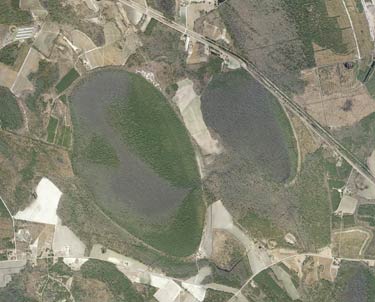Carolina Bays
 Carolina Bays are elliptical or oval depressions of uncertain origin found in North and South Carolina, along with a few bays in Georgia, Virginia and Delaware. They are considered to be a freshwater wetland, most often isolated. The bay's depression fills with rainwater, usually in winter and spring, and dries in the summer months. This water level determines the plants and animals that inhabit the bay.
Carolina Bays are elliptical or oval depressions of uncertain origin found in North and South Carolina, along with a few bays in Georgia, Virginia and Delaware. They are considered to be a freshwater wetland, most often isolated. The bay's depression fills with rainwater, usually in winter and spring, and dries in the summer months. This water level determines the plants and animals that inhabit the bay.
The Carolina Bay is sometimes called 'pocosin' which is the Indian word for "swamp on a hill." Bay swamps were so-called due to an abundance of bay trees. Carolina Bays are oriented in a northwest-southeast, shoreline-perpendicular direction and parallel to one another. They are characterized by nine (9) distinctive features which may be exhibited totally or in part with any given bay.
- elliptical or oval shape
- northwest-southeast orientation
- parallel axes
- raised sand rims
- depressed interior surfaces
- difference between interior and surrounding soils
- relatively shallow depths
- flat sandy bottoms beneath interior fill
Bays are potential refuges for numerous wetlands species within a given geographic area. Often theses species may be entirely restricted to local bays. These species include rare plants, amphibians, reptiles, wading birds and mammals.
For additional information see - Distribution and Status of Carolina Bays in South Carolina (Adobe PDF - file size 4M), by Stephen H. Bennett and John B. Nelson. SC Wildlife & Marine Resources Department. 1991.
Carolina Bay Total Size and Abundance Estimates per County
Some of the information above was taken from the Advance Identification of Carolina Bays for South Carolina Wetlands Protection (Adobe PDF - file size 9.5M) Report.
SCDNR Managed Lands with Carolina Bays on the Property
- Bennett's Bay Heritage Preserve
- Ditch Pond Heritage Preserve
- Lewis Ocean Bay Heritage Preserve
- Little Pee Dee State Park Bay Heritage Preserve
- Savage Bay Heritage Preserve
- Woods Bay Heritage Preserve
Adobe® Reader® is required to open the Adobe PDF files and is available as a free download from the Adobe® Web site.
